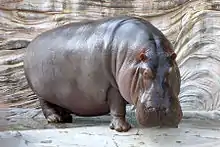Pseudoruminant
Pseudoruminant is a classification of animals based on their digestive tract differing from the ruminants. Hippopotami are ungulate mammals with a three-chambered stomach (ruminants have a four-chambered stomach) while equids (horses, asses, zebras) and rhinoceroses are monogastric herbivores.[1][2]
Anatomy
Like ruminants, some pseudoruminants may use foregut fermentation to break down cellulose in fibrous plant species (while most others are hindgut fermenters with a large cecum). But they have three-chambered stomachs (while others are monogastric) as opposed to ruminant stomachs which have four compartments.
Species
| Pseudoruminant | Image | Genus | Weight |
|---|---|---|---|
| Common hippopotamus |  |
Hippopotamus | 1.5 to 3.0 tons |
| Horse |  |
Equus | 380 to 999 kgs |
| One-horned rhinoceros | _4.jpg.webp) |
Rhinoceros | 1.8 to 2.7 tons |
| Coney |  |
Oryctolagus | 1 to 2.5 kgs |
See also
References
- Fowler, M.E. (2010). "Medicine and Surgery of Camelids", Ames, Iowa: Wiley-Blackwell. Chapter 1 General Biology and Evolution addresses the fact that camelids (including llamas and camels) are not ruminants, pseudo-ruminants, or modified ruminants.
- Laws, Richard (1984). The Encyclopedia of Mammals. New York: MacDonald D. ed. pp. 506–511. ISBN 0-87196-871-1.
This article is issued from Wikipedia. The text is licensed under Creative Commons - Attribution - Sharealike. Additional terms may apply for the media files.
